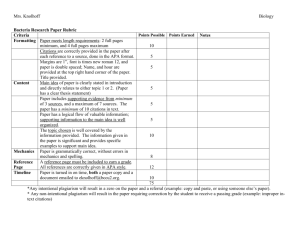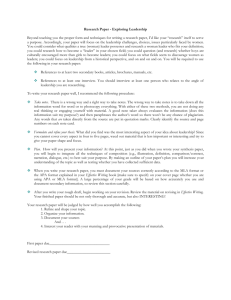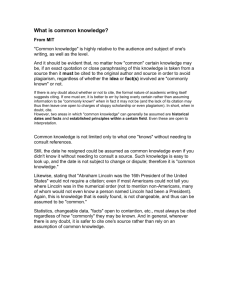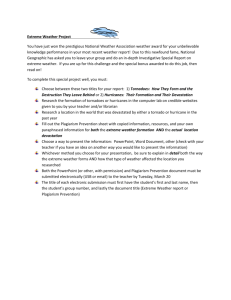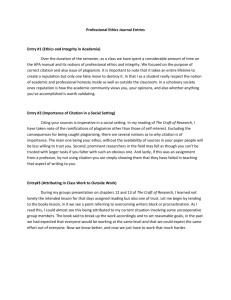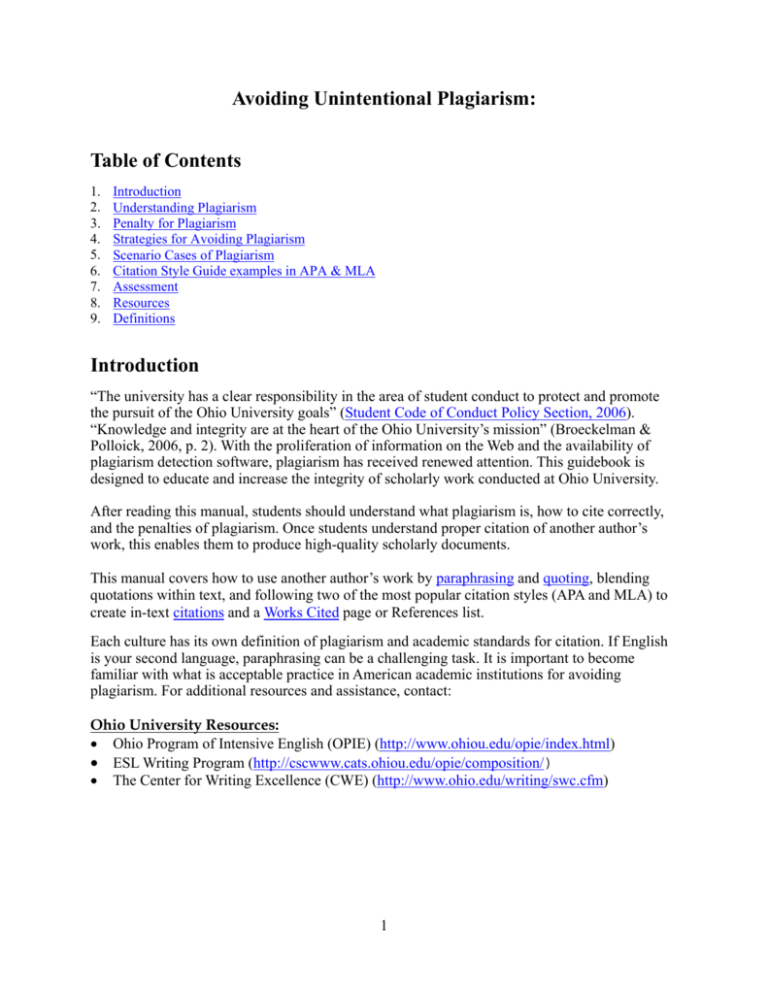
Avoiding Unintentional Plagiarism:
Table of Contents
1.
2.
3.
4.
5.
6.
7.
8.
9.
Introduction
Understanding Plagiarism
Penalty for Plagiarism
Strategies for Avoiding Plagiarism
Scenario Cases of Plagiarism
Citation Style Guide examples in APA & MLA
Assessment
Resources
Definitions
Introduction
“The university has a clear responsibility in the area of student conduct to protect and promote
the pursuit of the Ohio University goals” (Student Code of Conduct Policy Section, 2006).
“Knowledge and integrity are at the heart of the Ohio University’s mission” (Broeckelman &
Polloick, 2006, p. 2). With the proliferation of information on the Web and the availability of
plagiarism detection software, plagiarism has received renewed attention. This guidebook is
designed to educate and increase the integrity of scholarly work conducted at Ohio University.
After reading this manual, students should understand what plagiarism is, how to cite correctly,
and the penalties of plagiarism. Once students understand proper citation of another author’s
work, this enables them to produce high-quality scholarly documents.
This manual covers how to use another author’s work by paraphrasing and quoting, blending
quotations within text, and following two of the most popular citation styles (APA and MLA) to
create in-text citations and a Works Cited page or References list.
Each culture has its own definition of plagiarism and academic standards for citation. If English
is your second language, paraphrasing can be a challenging task. It is important to become
familiar with what is acceptable practice in American academic institutions for avoiding
plagiarism. For additional resources and assistance, contact:
Ohio University Resources:
• Ohio Program of Intensive English (OPIE) (http://www.ohiou.edu/opie/index.html)
• ESL Writing Program (http://cscwww.cats.ohiou.edu/opie/composition/)
• The Center for Writing Excellence (CWE) (http://www.ohio.edu/writing/swc.cfm)
1
Understanding Plagiarism
What is Plagiarism?
Plagiarism is using somebody else’s ideas or words without properly acknowledging the original
source. Plagiarism includes the use of “ideas and/or quotes from other writers without citing the
source, turning in an assignment for a class (unchanged) that you’ve already used for another
class, borrowing ideas or work from another student, and cutting and pasting information from a
site on the Internet without citing the source” (Rouse & Gut, 2001, p. 1). It is not necessary to
cite common knowledge, which can be defined or varied by your field or your instructor (WPA,
2003) as discussed below.
Some of the most common reasons students plagiarize include (James, Mclnnis, & Devlin, 2002;
Noah & Eckstein, 2001):
•
•
•
•
•
•
•
lack of understanding
time constraints
pressures to get and maintain a high GPA
temptation to take the easy way out
the un-likeliness of getting caught by the instructor
social acceptance of peers to engage in a certain level of academic dishonesty
the ease and availability of Internet sources
Examples of Plagiarism:
•
•
•
•
•
•
using another author’s ideas without citing the source
handing in a paper written by a friend
buying a paper on the Internet
paying someone to write a paper and handing it in as your own
copying-and-pasting information from the Internet or another source without properly
citing the author
inadequately paraphrasing a source so that the wording is too close to the original
What is Common Knowledge?
Common knowledge is widely known information about famous people, current events, facts, or
familiar history (Stern, 2007). This could be information that a student knows without looking it
up, information that is available from many sources, information in a dictionary that is looked up
to refresh a student’s memory, common sayings, or expressions (Stern, 2007). Common
knowledge can be different for each field of study or instructor. If students have questions
regarding common knowledge information used in their field, they should contact their instructor.
Professors can often identify plagiarized work by how closely the writing style matches that of
the student. Today there are many free online plagiarism services that help professors identify
plagiarized papers quickly if they suspect plagiarism has occurred.
2
What are the Penalties for Plagiarism?
While instructors may handle suspected plagiarism cases differently, the Ohio University Student
Handbook in the Student Code of Conduct policy section provides details on the steps that can be
taken to handle plagiarism cases (http://www.ohio.edu/judiciaries/conduct_policy.cfm). A student,
students, or student organization found to participate in academic misconduct are subject to
sanctions (reprimand, disciplinary probation, suspension, or expulsion).
Strategies for Avoiding Plagiarism
The following includes common practices that assist students in avoiding plagiarism. Many
instances of plagiarism occur due to a lack of planning or education on the part of the student. It
is the student’s responsibility to make sure he or she avoids plagiarism. Once a student
understands and practices paraphrasing, quoting, and citing other authors’ work, this becomes a
natural part of the writing process. When a student does not provide proper citations for another
author’s work due to a lack of knowledge, the passage is still considered plagiarism.
If students need assistance with citing sources in a document, they should refer to the citation
guide used in the discipline, talk to an instructor or advisor, or seek additional help at the Writing
Center on the 2nd floor of Alden Library (http://www.ohio.edu/writing/swc.cfm).
Why must I cite?
To avoid plagiarism, the student must learn how to cite other authors’ works in a specific citation
style, for example MLA or APA. There are two parts to documenting a citation—the in-text
citation and a list of references at the end.
APA in-text citation example of direct quote:
“Quotations must reproduce the original source word for word” (Stern, 2007, p. 19).
MLA in-text citation example of direct quote:
“Quotations must reproduce the original source word for word” (Stern 19).
APA in-text citation example of a paraphrased sentence:
Stern (2007) states if you use a direct quote in a paper, you must cite the original work.
MLA in-text citation example of a paraphrased sentence:
Stern states if you use a direct quote in a paper, you must cite the original work (19).
3
APA reference page example:
References
Stern, L. (2007). What every student should know about avoiding plagiarism. New York:
Pearson.
MLA reference page example:
Works Cited
Stern, Linda. What Every Student Should Know About Avoiding Plagiarism. New
York: Pearson, 2007.
What is Paraphrasing?
Writing effective paraphrases takes practice. Paraphrasing is the rewording in your own thoughts
of other authors’ ideas. A citation is used with the paraphrased sentence to acknowledge the
other author’s intellectual property, thoughts, and ideas. All paraphrased text must be cited. If
you do not cite an idea that you have paraphrased, this is considered plagiarism.
Following are examples of correctly paraphrased texts in both APA and MLA styles.
Original Text: “The most effective way to write a paraphrase is to read the original passage, put
the passage aside, and then compose your own restatement of the materials in the passage”
(Rosen, 2006).
Example in APA style paraphrased sentence: One recommended method for paraphrasing is
to read the text of interest, step away from the materials, and later restate the materials in your
own words (Rosen, 2006).
Example in MLA style with same paraphrased sentence: One recommended method for
paraphrasing is to read the text of interest, step away from the materials, and later restate the
materials in your own words (Rosen). For more than one article from the same author, use both
author and year in MLA style (Rosen 2008) without a comma between author and year.
Example of a PLAGIARIZED paraphrase: The best way to write a paraphrase is to read the
source passage, put it aside, and then write your own statement of the ideas in the original
(Rosen, 2006).
This example is plagiarized because the wording of the paraphrase is too close to the wording of
the original. It is important to completely change the wording and the sentence structure
whenever possible of an original source in order to avoid plagiarism.
4
How do I develop good practices?
Avoiding plagiarism takes effort and understanding on the part of the student. Several tips are
provided below to help you avoid plagiarism and improve your citation and reference
preparation skills:
• Organize your reference materials.
• Ask your instructor for assistance when you have questions.
• Practice writing correct citations every time you write.
• Take careful notes. If you quote a source, put it in quotes in your notes. If you paraphrase,
make sure you sufficiently change the sentence structure and vocabulary.
• Once you create a well formatted paper, use this document as a guide when formatting
references and citing properly in future documents.
• If you have a copy of an article, highlight the bibliography information on the paper (title,
author, web site, date retrieved, etc.) needed for the Works Cited or Reference list. Also,
highlight any part of the article needed, such as a direct quote, or paraphrase ideas in the
margin to include in your paper.
• Use a program that assists with writing references, such as, Endnotes or Refworks
(www.library.ohiou.edu/find/refworks). Note: These programs store and generate a
reference list, but they still require the student to check each reference for accuracy in
the writing style.
• Purchase the style guide recommended in your field. Obtain other quick-reference
guidebooks if needed.
• Use your Internet Browser to save your favorite writing style web sites, so you can
quickly reference them as needed to format citations in your document and to create a
Works Cited or Reference list. Or, visit Ohio University’s Alden Library website
http://www.library.ohiou.edu/find/style.html. From the Library’s homepage, click on the
link “Citation Style Guides” and then on APA, MLA, or Chicago style to see several
sources. Also, see other Web site links in the Resource section of this guidebook.
• When you are preparing notes for a paper, mark text with Q for quotations, P for
paraphrase, and M for my thoughts, so this information can be cited properly in the
document at a later time (The Catholic University of America, 2008). Also, remember to
collect the reference information that is needed at the end of the document.
Scenario Cases of Plagiarism
In order to paraphrase accurately, you have to understand the source materials so you can
sufficiently change the sentence structure and vocabulary of the original work. This takes
practice, but the more you practice, the easier it gets.
The slightly modified scenario case studies below were borrowed with permission from James E.
Fowler’s “Avoiding plagiarism: A Student Survival Guide”, based on information found at
http://www.ccc.commnet.edu/mla/plagiarism.shtml, the Capital Community College Guide:
A Statement on Plagiarism (See Appendix A: Permission of Use).
5
Original text: Elaine Tyler May’s “Myths and Realities of the American Family”:
Because women’s wages often continue to reflect the fiction that men earn the
family wage, single mothers rarely earn enough to support themselves and their
children adequately. And because work is still organized around the assumption
that mothers stay home with children, even though few mothers can afford to do
so, child-care facilities in the United States remain woefully inadequate.
Below are several possible uses of this text. As you read through each case, try to decide if it is a
legitimate use of May’s text or an example of plagiarism.
Case 1:
Since women’s wages often continue to reflect the mistaken notion that men are
the main wage earners in the family, single mothers rarely make enough to
support themselves and their children very well. Also, because work is still based
on the assumption that mothers stay home with children, facilities for child care
remain woefully inadequate in the United States.
Plagiarism or not?:
In case A there is too much direct borrowing in sentence structure and wording. The writer
changes some words, drops one phrase, and adds some new language, but the overall text closely
resembles May’s. Even with a citation, the writer is still plagiarizing because the lack of
quotation marks indicates that Case 1 is a paraphrase, and should thus be in the writer’s own
language.
Case 2:
As Elaine Tyler May points out, “women’s wages often continue to reflect the
fiction that men earn the family wage” (588). Thus many single mothers cannot
support themselves and their children adequately. Furthermore, since work is
based on the assumption that mothers stay home with children, facilities for day
care in this country are still “woefully inadequate” (May 589).
Plagiarism or not?:
The writer now cites May, so we’re closer to telling the truth about our text’s relationship to the
source, but this text continues to borrow too much language. This passage is still plagiarized
because the paraphrase is too similar to the original in sentence structure and vocabulary.
6
Case 3:
By and large, our economy still operates on the mistaken notion that men are the
main breadwinners in the family. Thus, women continue to earn lower wages than
men. This means, in effect, that many single mothers cannot earn a decent living.
Furthermore, adequate day care is not available in the United States because of
the mistaken assumption that mothers remain at home with their children.
Plagiarism or not?:
Case 3 shows good paraphrasing of wording and sentence structure, but May’s original ideas are
not acknowledged. Some of May’s points are common knowledge (women earn less than men,
many single mothers live in poverty), but May uses this common knowledge to make a specific
and original point and her original conception of this idea is not acknowledged, therefore, this
passage is also plagiarized. It could easily be fixed by citing May.
Case 4:
Women today still earn less than men—so much less that many single mothers
and their children live near or below the poverty line. Elaine Tyler May argues
that this situation stems in part from “the fiction that men earn the family wage”
(588). May further suggests that the American workplace still operates on the
assumption that mothers with children stay home to care for them (589). This
assumption, in my opinion, does not have the force it once did. More and more
businesses offer in-house day-care facilities…
Plagiarism or not?:
The writer makes use of the common knowledge in May’s work, but acknowledges May’s
original conclusion and does not try to pass it off as his or her own. The quotation is properly
cited, as is a later paraphrase of another of May’s ideas. This passage is not plagiarized. This
passage shows how all paraphrasing should be done. The source must be cited and the sentence
structure and wording must be changed significantly.
7
Citation Style Guide for APA & MLA
For the most current APA and MLA guidelines for Internet citation, etc., please visit
http://owl.english.purdue.edu/owl/resource/560/01/ or one of the other resources
listed in this guide.
Citing and Referencing Examples for APA Style
Book by one author for APA Style
Reference
Publication
Date
The name of
the publisher
Doe, A. L. (2004). How to write your papers: Common styles. Athens, OH: Free Press.
Last
name
First
name
initial
Middle
name
initial
Italicize - Title of Book
Capitalize – The first letter of the word of title and
subtitle
City name of
publication
Provide the state
when the city is
not well known.
In-Text Citation for this reference for APA Style
Doe (2004) indicates that students do not know how to use APA style correctly.
Last
name
Publication
year
Or
Students do not know how to use APA style correctly (Doe, 2004).
8
Book by two or more authors for APA Style
Reference
Middle
name
initial
First
name
initial
Use
ampersand
Italicize - Title of Book
Capitalize – The first letter of the word of title and subtitle
Doe, A. L., & Smith, J. K. (2005). Why do we have to use APA style when we write papers.
Boston: Open Press.
Indent
Double
Space
If it is well known
city or certain
ones, no need to
provide the state.
The name of
the publisher
In-Text Citation for this reference for APA Style
Doe and Smith (2005) report that few students use APA style correctly when they write
their papers.
Or
and is typed
out in text
Use
ampersand
Only a few students use APA style correctly when they write their papers (Doe & Smith,
2005).
In-Text citation for more than three authors
If it is mentioned the first time, it has to list all authors’ names. After the first time, use
only first author’s name and use “et al.”
9
Book by three or more authors for APA Style
Reference
First
name
initial
Middle
name
initial
Use
ampersand
Italicize - Title of Book
Capitalize – The first letter of the word of title and subtitle
Doe, A. L., Calm, S. A., & Smith, J. K. (2005). Why do we have to use APA style when we
write papers. Boston: Open Press.
Indent
Double
Space
Well known place.
It doesn’t need to
provide the state.
The name of
the publisher
In-Text Citation for this reference first time
Doe, Calm and Smith (2005) report that few students use APA style correctly when they
write their papers.
Or
and is typed
out in text
Use
ampersand
Only a few students use APA style correctly when they write their papers (Doe, Calm &
Smith, 2005).
In-Text citation for this reference after first time
Doe, et al. (2005) reported that few students use APA style correctly when they….
Or
Only a few students use APA style correctly when they write their papers (Doe, et al.,
2005).
10
Journal Article by one author for APA Style
Reference
Title of article. Not Italicized.
Capitalize – The first letter of the word of title and subtitle
Doe, A. L. (2005). How to use APA style correctly in your paper. Writing Style for All, 8,
155-165.
Italicize – The periodical title & the volume number
Capitalize-use title case.
Page numbers
In-Text Citation for this reference
Anderson (2007) states, “All material taken directly from any other document must be
enclosed in quotation marks” (p. 16).
Or
If you use a direct quote,
the page number needs to be provide
A common practice and method for avoiding academic dishonesty is that “all material
taken directly from any other document must be enclosed in quotation marks”
(Anderson, 2007, p. 16).
11
Article in an Internet-only newsletter for APA Style
Reference:
Publication
date and month
Title of article
Smith, J. (2003, June). Why students need to know how to use APA style—Project
updated. Campus News, 4. Retrieved September 25, 2004, from
http://www.campuslife.net/20030605/newsletter/234g.html
Internet periodical title.
If volume not available,
ignore it.
The date you
retrieved the
document
No period at the end
No hyperlink
underline for
address
In-Text Citation for this reference
Smith (2003) states that students often do not see the advantages to citing sources.
Or
“Students do not realize the benefits of using citations” (Smith, 2003, p. 1) when they
write.
12
Citing and Referencing Examples for MLA Style
Book by one author for MLA Style
Reference
Underline - Title of Book
Capitalize – All important words
Use comma
Publication
Date
Doe, Amy L. How to Write Your Papers: Common Styles. Boston: Hocking, 2005.
Last
name
First
name
City
publication
Middle
name
initial
Use an
abbreviated
publisher’s name
In-Text Citation for this reference
Amy Doe indicates that students do not know how to use MLA style correctly (45).
First
name
Page number for
paraphrased text from
original source
Last
name
Or
Students do not know how to use MLA style correctly (Doe 45).
Last name.
Add the first initial
in front if more than
one author shares the
same name.
13
Book by two or more authors for MLA Style
Reference
Last
name
initial
First name
& middle
name initial
Use
and
First and Last name
Underline - Title of Book
Capitalize – All important words
Doe, Amy L., and John Smith. Why Do We Have to Use MLA Style When We Write
Papers? New York: Open P, 2005.
Indent
City
publication
Double
Space
Publication
Date
The publisher’s name and
use abbreviate P for Press &
U for University
In-Text Citation for this reference
First & last
name
Amy Doe and John Smith report that few students use MLA style correctly when they
write their papers (15).
Or
and is typed
out in text
Page number for
paraphrased text from
original source
Few students use APA style correctly when they write their papers (Doe and Smith 15).
Only last name
14
Journal Article by one author for MLA Style
Reference
Quotation mark - Title of article
Capitalize – All important words
Underline – The journal title
Doe, Amy L. “How to Use MLA Style Correctly in Your Paper.” Writing Style for
All 8 (2005): 155-165.
Volume
number
Publication
Date
Page numbers
In-Text Citation for this reference
First
& last
name
Amy Doe states, “All material taken directly from any other document must be
enclosed in quotation marks” (16).
If you use a direct quote,
the page number needs to be provided.
Or
A common practice and method for avoiding academic dishonesty is that “all material
taken directly from any other document must be enclosed in quotation marks” (Doe
156).
15
Article in an Internet-only newsletter for MLA Style
Reference
Quotation mark - Title of article
Capitalize – All important words
Internet periodical
title. If they don’t
use volume or issue
numbers, ignore it.
Smith, John. “Why Students Need to Know How to Use MLA Style.” Campus News
on the Web 4 April 2003. 25 Sep. 2006
<http://www.campuslife.net/20030605/newsletter/234g.html>.
Publication
date, month
& year
The date you
retrieved the
document
No underline under web
address. Add “<” before
and “>” after the web
address and add a
period at the end.
In-Text Citation for this reference
John Smith suggests that students do not understand the advantages of using citations.
Or
No date listed after the
name in text
Enter last name only and page
number without a comma
“Students do not realize the benefits of using citations” (Smith 5).
16
Assessment Questions
1. At the heart of OU’s mission is:
a. Education
b. Cultural experience
c. Knowledge and integrity
d. Learning
e. None of the above
2. This manual is designed to help students:
a. understand penalties for academic dishonesty
b. develop strategies for avoiding plagiarism
c. increase the quality of scholarly writing
d. all of the above
3. Some of the most common reasons that people plagiarize are:
a. Time constraints, pressure to maintain GPA, social acceptance, and ease of
copying and pasting from a Internet source
b. Time constraint and over achiever
c. My friend said it was okay
d. Because in my country, we do not cite other author’s work
e. None of the above
4. One of Ohio University sanctions for academic dishonesty is:
a. Expulsion
b. Detention
c. Meeting with college dean
d. Written statement from teacher
e. None of the above
5. One strategy for avoiding plagiarism is to use this coding system when making
notes of other author’s work:
a. Q for quotations, P for partially copies, and M for might need later
b. Q for quote, P for paraphrase, and M for my thoughts
c. Q for quick line, P for in-part, and M for my thoughts
d. None of the above
17
6. T or F
Effective paraphrasing is not as easy as it appears.
7. T or F
Paraphrasing allows you to use common-knowledge words in your
statements without citing your source.
8. T or F
Common-knowledge is widely known information.
9. T or F
Using an assignment that you turned in previously is not considered
plagiarism?
10. T or F
Cutting and pasting information from the Internet is acceptable as long as
you cite your source and use quotation marks if you use the exact text.
APA Style Questions
11. When you write a reference for a book, which part is italicized?
a. Author’s name
b. Title of book
c. The name of the publisher
d. Publication date
12. When you write a reference for journal article, which part is italicized?
a. Author’s name
b. Title of article
c. Title of journal
d. Page numbers
13. When you use a direct quote, you have to provide three pieces of information in the
text citation. These are:
a. Author’s last name, first name, and publication date
b. Author’s first name, publication date, and page number
c. Author’s last name, publication date, and page number
14. When you write a reference for an article found in an Internet-only newsletter,
which one do you not need?
a. Provide the author’s name
b. Provide the title of article
c. Provide the retrieved date
d. Provide the web address with the hyperlink underlined
18
MLA Style Questions
15. When you write a reference for a book, which part is underlined?
a. Author’s name
b. Title of book
a. The name of the publisher
b. Publication date
16. When you write a reference for journal article, which part is underlined?
a. Author’s name
b. Title of article
c. Title of journal
d. Page numbers
17. When you use a direct quote, you have to provide three pieces of information in the
text citation. These are:
a. Author’s last name, first name, and publication date
b. Author’s first name, publication date, and page number
c. Author’s last name and page number (unless multiple articles are from the
same author)
d. Author’s first name, last name, and page number
18. When you write a reference for an article found in an Internet-only newsletter,
which one do you not need?
a. Provide the author’s name
b. Provide the title of article
c. Provide the retrieved date
d. Provide the web address with the hyperlink underlined
Answer key: 1=c, 2=d, 3=a, 4=a, 5=b, 6=T, 7=T, 8=T, 9=F, 10=T, 11=b, 12=c, 13=c, 14=d,
15=b, 16=c, 17=c, 18=d
19
Resources
Ohio University Resources
• Ohio Program of Intensive English (OPIE) (http://www.ohiou.edu/opie/index.html)
• ESL Writing Program (http://cscwww.cats.ohiou.edu/opie/composition/)
• The Center for Writing Excellence (CWE) (http://www.ohio.edu/writing/swc.cfm)
Copyright Law Articles:
A Brief Intro to Copyright (http://www.templetons.com/brad/copyright.html)
10 Big Myths About Copyright Explained (http://www.templetons.com/brad/copymyths.html)
Copyright Law and New Technologies (http://www.educationworld.com/a_curr/curr280c.shtml)
Is Fair Use a License to Steal? (http://www.educationworld.com/a_curr/curr280b.shtml)
Citation and References Guides:
APA Style Guides (Social Sciences)
American Psychological Association (http://www.apastyle.org/elecref.html)
Ohio State University's APA Guide (http://library.osu.edu/sites/guides/apagd.php)
The OWL at Purdue APA Guide (http://owl.english.purdue.edu/owl/resource/560/01)
Dianahacker APA Guide (http://www.dianahacker.com/resdoc/social.html)
Capital Community College Guide (http://www.ccc.commnet.edu/mla/plagiarism.shtml)
MLA Style Guides (Humanities)
Dianahacker MLA Guide (http://www.dianahacker.com/resdoc/humanities.html)
The OWL at Purdue MLA Guide (http://owl.english.purdue.edu/owl/resource/557/01)
Ohio State University’s MLA Guide (http://library.osu.edu/sites/guides/mlagd.php)
Case Studies on Plagiarism:
Penn State University (http://istudy.psu.edu/FirstYearModules/CopyrightPlagiarism/CaseStudies.html)
Indiana University (http://www.indiana.edu/~istd/examples.html)
Test your Knowledge about Plagiarism:
Indiana University (http://www.indiana.edu/~istd/plagiarism_test.html)
20
References
Anderson, C. E., Carrell, A. T., & Widdifield, J. L. (2007). Citing sources with APA
documentation. New York: Pearson.
Broeckelman, M. A., & Pollock, T. P. Jr. (2006), March 13). An honest look at academic
dishonesty at Ohio University. Retrieved July 10, 2006, from
http://oak.cats.ohiou.edu/~mb128405/final%20report.pdf
American Psychological Association. (2001). Publication manual of the American
Psychological Association (5th ed.). Washington, DC: Author.
Capital Community College. Retrieved January 14, 2009, from
http://www.ccc.commnet.edu/mla/plagiarism.shtml
The Catholic University of America, Department of English. Avoiding Plagiarism.
Retrieved on January 14, 2009, from libraries.cua.edu/instruct/AvPlagiarism.doc
Council of Writing Program Administrators. (2003). Defining and Avoiding Plagiarism:
The WPA Statement on Best Practices. Retrieved October 5, 2006, from
http://www.ilstu.edu/~ddhesse/wpa/positions/WPAplagiarism.pdf
Fowler, J. (2003). “Avoiding plagiarism: A student survival guide.” Based on
http://www.ccc.commnet.edu/mla/plagiarism.shtml. Retrieved September 15, 2006 from
http://www.ece.msstate.edu/~fowler/Classes/plagiarism.pdf .
Greer, M. (2007). Citing sources with MLA documentation. New York: Pearson.
Gibaldi, J. (2003). MLA handbook for writers of research papers (6th ed.). New York:
Modern Language.
21
James, R., Mclnnis, C., & Devlin, M. (2002). Centre for the Study of Higher Education.
Minimising Plagiarism. Retrieved July 15, 2006, from
http://www.cshe.unimelb.edu.au/assessinglearning/docs/PlagMain.pdf
Lipson, C. (2004). Doing honest work in college: how to prepare citations, avoid plagiarism, and
achieve real academic success. Chicago: University of Chicago.
Noah, H., & Eckstein, M. (2001). Fraud and education: The worm in the apple. Rowman &
Littlefield Publishers, Lanham, Md.
Ohio University Student Code of Conduct Policy (2006). Retrieved August 25, 2006,
from http://www.ohio.edu/judiciaries/conduct_policy.cfm
Rosen, Leonard J. (2006). The academic writer’s handbook. New York: Pearson Longman.
Rouse, A. M., & Gut, D. M. (2001). Plagiarism: What is it and how to avoid it. Ohio
University. Created for the 200 block education course.
Schank, R. C. (1984) The cognitive computer: On language, learning, and artificial
intelligence. Reading, MA: Addison-Wesley.
Stern, L. (2007). What every student should know about avoiding plagiarism. New York:
Pearson.
22
Definitions
APA Style – APA stands for American Psychological Association. The Publication Manual of
the American Psychological Association (2001) (APA) sets the citation and reference style for
the fields of education, psychology, behavioral and social sciences, as well as nursing,
criminology, and personnel management.
Citation – A citation is a reference within text to other author’s work. The in-text citation refers
to a reference in the Works Cited (MLA Style) or References (APA Style) section at the end of
the paper.
MLA Style – MLA stands for Modern Language Association. The 2003 MLA Handbook for
Writers of Research Papers sets the citation and reference style for English and other fields of
study.
Paraphrasing – Paraphrasing is the rewording of an author’s ideas using your own thoughts. A
citation is used with the paraphrased sentence to acknowledge the other author’s intellectual
property, thoughts, and ideas.
Plagiarism is using somebody else’s ideas or words without properly acknowledging the original
source. Plagiarism includes the use of “ideas and/or quotes from other writers without citing the
source, turning in an assignment for a class (unchanged) that you’ve already used for another
class, borrowing ideas or work from another student, and cutting and pasting information from a
site on the Internet without citing the source” (Rouse & Gut, 2001, p. 1). It is not necessary to
site common knowledge, which can be defined or varied by your field or your instructor (WPA,
2003).
References – a correctly formatted list (author, title, journal or book name, volume, page
numbers, etc.) that appears in the Works Cited or References section.
23
Appendix A: Permission of Use
------------ Forwarded Message -----------Date: Monday, November 10, 2008 2:12 PM -0600
From: "James E. Fowler"
To: Angela McCutcheon
Subject: Re: Permission to use your scenario cases
Ms. McCutcheon:
Sorry for the delayed response - I was in France all last week and just
returned last evening.
1) Yes, it is no problem for you to use any or all of my manuscript on
plagiarism. However, I do point out that the central scenarios in my
manuscript originated at http://www.ccc.commnet.edu/mla/plagiarism.shtml the examples themselves, though, were created by an unknown author at Smith
College. So it might be best to cite this website in addition to (or instead
of) my work.
-Jim
-=======================================================================
|
Dr. James E. Fowler
|
|
Professor and Interim Graduate Program Director
|
|
Department of Electrical & Computer Engineering
|
|
GeoResources Institute (GRI)
|
|
Mississippi State University
|
|
|
|
fowler@ece.msstate.edu
|
|
http://www.ece.msstate.edu/~fowler
|
|
|
---------- Postal Address ---------------------- Contact Info ---------
24



